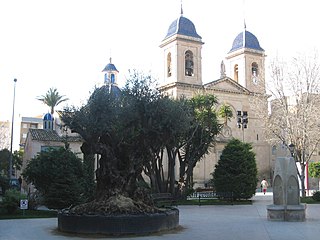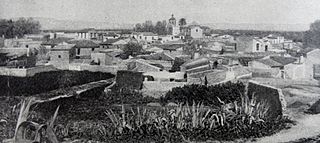
Sant Joan d'Alacant or San Juan de Alicante is a municipality belonging to Alicante metropolitan area, in the southeast of Valencian Community, Spain. It is the geographic center of the Old Garden of Alicante. Its limits are with the settled areas of Alicante (7 km), Mutxamel (1 km) and El Campello (3 km). It is within the Alicante metropolitan area and shares the same fire department and metro services. Its population growth is due to its function as a bedroom community, as well as in recent years, its isolation from tourist areas, its cultural and academic activities, and because has part of the campus of the University Miguel Hernández of Elx/Elche. It comprises two zones: the town of Sant Joan and Benimagrell, which is now joined through its urban expansion.

The Autovía A-31, also known as the Autovía de Alicante, is a highway in Spain. The road connects Madrid to Alicante.

The University of Alicante was established in 1979 on the basis of the Center for University Studies (CEU), which was founded in 1968. The university main campus is located in San Vicente del Raspeig/Sant Vicent del Raspeig, bordering the city of Alicante to the north. As of 2011/12 academic year, there are approximately 27,500 students studying there.

Onil is a town located in the comarca of L'Alcoià, in the province of Alicante, Spain. It has an area of 48.41 km2 and, according to the 2006 census, a total population of 7466 inhabitants and a population density of 154.22 inhabitants/km2. Onil is located next to the mountain called Sierra de Onil in the Sierra de Mariola, 36 km from Alicante city.

Fageca is a municipality in the comarca of Comtat, Alicante, Valencia, Spain.

Famorca is a municipality in the comarca of Comtat, Alicante, Valencia, Spain.

Millena is a municipality in the comarca of Comtat, Alicante, Valencia, Spain.

One of the worst bombing attacks on civilian population in Alicante during the Spanish civil war. This particular attack was one of many against the Spanish city of Alicante and it occurred on 25 May 1938, perpetrated by the Legionary Air Force, an expeditionary corps from the Italian Royal Air Force, allied with Franco. The attacking planes were based in Mallorca. It is even considered by many to be one of the deadliest aerial bombings of the entire Spanish Civil War with many bombs dropped on a strictly civilian population with no military targets within a short amount of time. It was heavily reported by witnesses that the planes dove low shooting at civilians randomly.

Granja de Rocamora is a village in the province of Alicante and autonomous community of Valencia, Spain. The municipality covers an area of 7.2 square kilometres (2.8 sq mi) and as of 2011 had a population of 2463 people.

Hondón de los Frailes is a municipality and village in the province of Alicante and autonomous community of Valencia, Spain. The municipality covers an area of 12.6 square kilometres (4.9 sq mi) and as of 2018 had a population of 1132 people.

Monforte del Cid is a village in the province of Alicante and autonomous community of Valencia, Spain. The municipality covers an area of 79.5 square kilometres (30.7 sq mi) and as of 2011 had a population of 7,771 people.

Murla is a village in the province of Alicante and autonomous community of Valencia, Spain. The municipality covers an area of 5.81 square kilometres (2.24 sq mi) and as of 2022 had a population of 540 people.

Rafal is a municipality in the Valencian Community (Spain) situated in the south of the province of Alicante, in the comarca of Vega Baja del Segura. The municipality covers an area of 1.6 square kilometres (0.62 sq mi) and as of 2011 had a population of 4162 people.

Rojales is a village in the province of Alicante and autonomous community of Valencia, Spain. The municipality covers an area of 27.6 square kilometres (10.7 sq mi) and as of 2011 had a population of 21583 people.

San Fulgencio is a village in the province of Alicante and autonomous community of Valencia, Spain. The municipality covers an area of 19.75 square kilometres (7.63 sq mi) and at the 2011 Census had a population of 9,572, of whom 77% were of foreign origin; the latest official estimate was 7,855. English was the most spoken language in the town

San Isidro is a village in the province of Alicante and autonomous community of Valencia, Spain. The municipality covers an area of 11.69 square kilometres (4.51 sq mi) and as of 2011 had a population of 1934 people.

College of the Immaculate, Alicante, Spain, was founded by the Society of Jesus in 1954. It is coeducational and includes three-year-olds through primary, secondary (ESO), and baccalaureate.
St. Stanislaus Kostka College, Salamanca, is a Jesuit college founded in 1952. It grew gradually after 1952 with the efforts of Jesuits to organize a parish in the Prosperity district of Salamanca, Spain. It now accommodates children from infant through secondary (ESO).
The siege of Alicante took place from December 1708 to April 1709 during the War of the Spanish Succession. The city of Alicante was besieged by a French and Spanish force loyal to Philip V. They were opposed by the garrison, an Allied force under the command of John Richards.

Alicante is one of the 59 constituencies represented in the Senate, the upper chamber of the Spanish parliament, the Cortes Generales. The constituency elects four senators. Its boundaries correspond to those of the Spanish province of Alicante. The electoral system uses an open list partial block voting, with electors voting for individual candidates instead of parties. Electors can vote for up to three candidates.



















